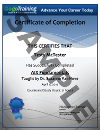Course Description
This iOS 8 course will show you how to write mobile applications for Apple’s popular iPhone and iPad. This course is fully updated for Xcode 6, iOS 8, and Objective-C. You’ll begin the course by learning how to use Xcode 6 to build and debug iOS 8 applications that run on the iOS Simulator. You will then learn how iOS 8 applications display views, learn to use view controllers, display alerts, play multimedia, and more. At the end of the course you will have written 10 apps and be able to write your own iPhone and iPad apps.
This course includes over 18 lecture and 7.7 hours of video instructions. In this course you will create 10 apps including a Touch Counter App that responds to your touches on the screen and increments a counter; a touch counter app using buttons; a name and phone number app; a text editor app; an input control fun app; an HTML app; a stock price app, an email and text app; an image app and an audio app. And all of these apps and exercises will prepare you to create your own iPhone and iPad apps.
In This Course You Will Learn:
- Utilize Xcode 6 to write and debug iOS 8 applications for both iPhone and iPad
- Use the Xcode 6 Interface Builder to lay out your user interface
- Write iOS apps using Objective-C
- Create Single View Controller apps
- Create Multi View Controller apps
- Make use of iOS 8 controls such as labels and buttons
- Run your apps on the iPhone/iPad simulator
Prerequisites
Completion of Objective-C Programming Using Xcode 6 from GogoTraining or equivalent experience.
Outline
Module 00: Course Introduction - iOS 8 Programming
Module 01: Introduction to Xcode 6
- Starting Up Xcode
- Creating a new Xcode Project
- Project Templates and Options
- Building, Running, and Stopping
- Show/Hide Navigator
- Show/Hide Tools/Utilities
- Demo: Tour of Xcode 6
Module 02: iOS 8 Application Concepts
- Application Startup, Delegate and Lifecycle
- MVC – Model, View, Controller
- Main Storyboard
- Launch Screen
- Image Assets
- Info.plist
- Demo: Tour of an iOS 8 App
Module 03: Displaying Text With UILabel
- UILabel and IBOutlet
- UILabel as Plain Text
- UILabel as Attributed Text
- UILabel as Multi-Line Text
- Demo: Exploring UILabel
- Exercise: Creating a Touch Counter App with UILabel
Module 04: Displaying Buttons With UIButton
- UIButotn and IBAction
- UIButton and IBOutlet
- Demo: Exploring UIButton
- Exercise: Creating a Touch Counter App with UIButton
Module 05: Keyboard Input with UITextField
- About Keyboard Input
- Keyboard Choices
- Keyboard Input using UITextField
- Demo: Exploring Keyboard Input
- Exercise: Keyboard Input of Name and Phone Number
Module 06: Using UITextView
- About UITextView
- UITextView for Text Output
- UITextView for Keyboard Input
- Demo: Exploring UITextView
- Exercise: Using UITextView as Simple Editor
Module 07: Alerting Users
- Alerting Users Options
- Alerting Users with UIAlertView
- Alerting Users with UIActionSheet
- Alerting Users with UIAlertController
- Demo: Exploring Alerting Users
- Exercise: Alerting User While Filling Out Form
Module 08: More Touch Input Controls
- Switch
- Segmented Control
- Slider
- Stepper
- Date Picker and Picker View
- Demo: Exploring More Touch Input Controls
- Exercise: Input Control Fun and Saving State
Module 09: Displaying HTML with UIWebView
- About UIWebView
- Display URL in Browser
- Displaying HTML Strings
- Displaying HTML Files
- Displaying HTML URLs
- Demo: Exploring UIWebView
- Exercise: Using UIWebView
Module 10: Accessing Web Services
- About Web Service Access
- -[NSString stringWithContentsOfURL:]
- NSURLConnection
- Demo: Exploring Web Services
- Exercise: Accessing Stock Price Web Service
Module 11: Working with Images
- Image Use in iOS 8
- Image Assets
- Using UIImage
- Using UIImageView
- Image Animation
- Demo: Exploring Images
- Exercise: Images and Animation
Module 12: Sending Email and Text
- MessageUI Framework
- About Sending Email
- About Sending Text
- Demo: Exploring Sending Email and Text
- Exercise: Sending Email and Text
Module 13: Two View Controllers with XIBs
- Concepts of Multiple View Controllers
- Creating XIB Files
- Sending Data Into XIB Files
- Receiving Data from XIB Files
- Demo: Exploring Multiple View Controllers with XIBs
- Exercise: Sending the Count To/From Two View Controllers
Module 14: Multiple Controllers with Storyboards
- About Storyboard File
- Creating View Controllers in Storyboards
- Sending Data using Segues
- Receiving Data from Storyboards
- Demo: Exploring Storyboards
- Exercise: Sending/Receiving Data Using Storyboards
Module 15: Navigation Controller
- About Navigation Controller
- Using Navigation Controller at Runtime
- Using Navigation Controller with Storyboard
- Using Segue and Delegate to send/receive data
- Demo: Exploring Navigation Controller
- Exercise: Using Navigation Controller
Module 16: Tab Bar Controller
- About Tab Bar Controller
- Using Tab Bar Controller at Runtime
- Using Tab Bar Controllers with Storyboard
- Using Data Model with Tab Bar Controller
- Demo: Exploring Tab Bar Controller
- Exercise: Using Tab Bar Controller
Module 17: Table View Controller
- About Table View Controller
- Table View Controller at Runtime
- Table View Controller with Storyboard – Static
- Table View Controller with Storyboard - Dynamic
- Demo: Exploring Table View Controller
- Exercise: Using Table View Controller
Module 18: Playing Audio
- Playing Audio with AudioToolbox
- Playing Audio with AVFoundation
- Playing Audio/Video with MediaPlayer
- Playing Audio/Video with AVKit
- Demo: Exploring Playing Audio
- Exercise: Playing Audio


